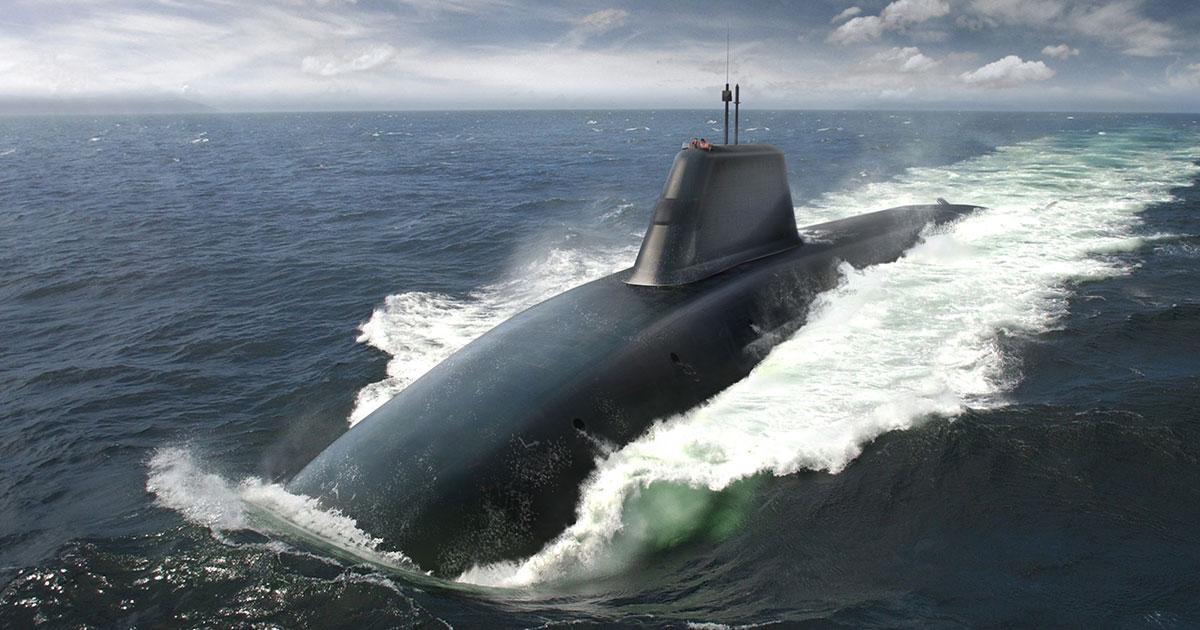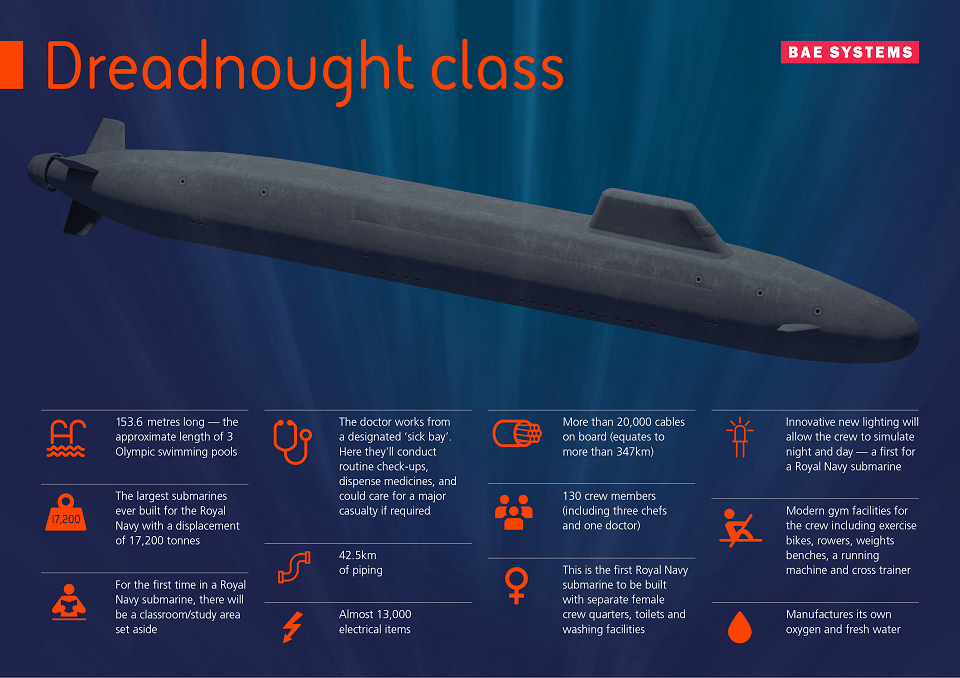Dreadnought Class: The UK’s Most Advanced Submarine Platform

This year marks the 50th anniversary of Continuous At Sea Deterrent - CASD50 - the longest unbroken operation ever delivered by the UK.
It is known as Operation Relentless. Of course, the future will require an even more robust deterrent that builds on the heritage, people, and technology that have kept the UK safe. For five decades, the engineers at BAE Systems have worked side-by-side with the Royal Navy to deliver advanced and complex defense programs.
Today, BAE is working hard to design, build and deliver the next class of deterrent submarines – the Dreadnought class - the most advanced submarine platform ever conceived for the Royal Navy.
 More advanced than a space rocket?
More advanced than a space rocket?
They’re not more complicated, they are a completely different realm of engineering…"
So began a news article published in 2014, describing the complexity of nuclear-powered Astute submarine design and manufacture within BAE System’s Submarines business. In that same piece, a question was posed: is building a submarine really more complex than building a rocket bound for space?
It will always be a theoretical debate of course, but it is worth examining some of the statistics around today's design and build of the Dreadnought class.
The Dreadnought program will develop deterrent submarines due to enter service in the 2030s with a crew of 130. The platform will be capable of operating for at least three decades.
It needs to operate hundreds of meters under the sea, in some of the world's most hostile environments. The water pressure and corrosive elements Dreadnought needs to withstand are huge. The engineering and build requirements behind successive submarine programs have become ever more challenging as the capability and complexity of each has increased.
In the case of Dreadnought, the new submarines reflect a completely new design which takes account of advances in design techniques, production methods and technology.
“You are effectively taking a 130-bed hotel and making it so you don’t need to deliver anything to that hotel for many months,” explains Jason Dobb, BAE Systems Chief Naval Architect. Jason has been with the Company close to 30 years and has worked on a number of platforms including the Vanguard and Astute classes.
“You need to power it off a safe reactor, make sure it can manufacture its own water and air and ensure that, for those on board, it is comfortable no matter what the external environment is – whether you are in freezing waters or the tropics. It needs to be undetectable and yet be able to detect everything around it. It is hugely complex, but it means there is always a challenge you need to overcome.”
Burring reality
Working on highly advanced submarines which are over a hundred meters long, with dozens of kilometers of piping and hundreds of kilometers of cabling, throws up many challenges.
With vessels of such complexity, it’s not always been possible, for example, to predict on paper whether every single component will be within easy reach once the crew is on board.
Yet, thanks to the use of modern technology, this is just one of the many examples within BAE Systems business of where age-old design concerns are being solved by recent innovations. The deployment of state-of-the-art equipment - in this case a clever adaptation of gaming technology - at the company’s site in Barrow is playing an increasing role in ensuring the design and manufacture of the UK’s submarines more efficient and effective than it has ever been.
Designers and engineers are making ever-greater use of virtual reality and augmented reality technology to test the physical layout of submarine interiors before they are built.
Another part of the design phase makes use of immersive 3D virtual reality equipment, such as headsets, to map out a range of design questions. For example, the technology may be used to view an electronic rendering of an area of the interior of a submarine, showing exactly where components such as valves will be located on each vessel.
That allows real-time tests to be performed on how easily a component can be accessed by crew or whether the design of a particular section is practical, with the valuable feedback informing the final design.
Increasingly, the business is making use of augmented - or mixed - reality technology. Designers are replicating parts or components of submarines in real life and supplementing them with software which recreates the rest of the submarine electronically.
Challenges
“Immersive Virtual Reality headsets enable someone of any experience or background to instantly step into the shoes of someone else in the program - such as Production, an Operator, or a Maintainer - and understand the challenges presented by the physical environment," explains James Graves, Bae Systems Technologist.
"Questions such as can you reach or see around that pipe to weld, do you even fit through that confined space? In the past you might not have known until entering the built compartment. The virtual world can be combined with physical props to add even more realism. This could be holding a physical welding torch, giving the user a realistic weight and feel, or a barrier to lean against providing support.”
The drive to succeed
In the fast-paced world of track racing, split second advantage is everything. That means the engineers behind every car understanding every possible permutation about how the vehicle interacts with the air, the weather and the external environment around it.
It already sounds a challenging task. Now scale up to something more than 40 times as long as an average racing car. Add more than 17,000 tonnes to its weight and the additional element of a crew of up to 130. Then subject it to further unpredictable forces. Factor in the need for high maneuverability, the ability to change speed and depth effectively, the need for stealth, range, the ability to detect, the safety of the men and women on board and any number of other operationally-critical variables needed to deliver capability which is world-leading.
Therein lie just some of the many complex and vital challenges facing the design and testing experts at BAE Systems’ Submarines business.
And while the worlds of high-octane driving and the design, manufacture, test and commissioning of the Royal Navy’s submarine fleets may seem a world away, some of the techniques used by BAE Systems today - ensuring that they deliver robust, capable and flawless platforms to the Navy - do have a number of similarities.
Engineers working for the world's leading race teams often use ‘Computational fluid dynamics’ analysis software to predict airflow over car designs. At the company’s site in Barrow, the process is used to assess whether a submarine design will travel through the water in the way it should and how it interacts with that environment. This forms a vital part of the design phase of each submarine, ensuring what they produce behaves in the specified way.
The computer modelling used informs the build of scale models of parts of BAE Systems’ submarine platforms, which are put through their paces in test tanks designed to ensure that each platform has the required capability on the surface and under the water.
As technology continues to develop, BAE Systems’ people are at the leading edge of what is possible in design and test of submarine platforms. Some of the other techniques in the design of their submarines program include:
Finite element analysis
Analysis carried out to ensure submarines, or parts of them, are able to take the loads required of them once they are in service. For example, extremely heavy pieces of machinery are often used on board and it is important to ensure that the deck of each submarine is able to comfortably handle the load.
A step beyond the conventional...
BAE Systems engineers and designers are continually pushing the envelope of what they understand according to conventional science. Physics text books may provide a number of graphs and explanations of how different materials will behave in different environments. In the process of testing the incredibly advanced and complex vessels being built in Barrow, the people at BAE Systems are sometimes finding they are going beyond the boundaries of what has been recorded before – they are effectively ‘creating’ new scientific output for the first time.
Imagine taking a substance, such as a liquid or a gas, and putting that substance under particular pressures. The effects of pressure - on speed, on the ability to maneuver - have been recorded to an extent. However, in the course of what their business does, BAE Systems seeks to provide the customer with a critical edge, to provide platforms which push the boundaries of what has been possible before. And that means at the earliest stages of testing they are having to put materials under stresses and conditions in excess of what has ever been measured previously.
It’s all part of the company’s continuing mission, alongside their partners across industry, to ensure the submariners of the Royal Navy are equipped with capability at the leading edge of what is possible.

